Kia Stinger: Engine Electrical System / Battery
Specifications
▷AGM80L - DIN
Item
|
Specification
|
Capacity [20 hr / 5 hr] (AH)
|
80 / 64
|
Cold Cranking Amperage (A)
|
800 (SAE) / 800 (EN)
|
Reserve Capacity (Min)
|
155
|
Specific Gravity
|
1.28 - 1.34 [25°C (77°F)]
|
Voltage (V)
|
12
|
▷CMF80L - DIN
Item
|
Specification
|
Capacity [20 hr / 5 hr] (AH)
|
80 / 64
|
Cold Cranking Amperage (A)
|
660 (SAE) / 660 (EN)
|
Reserve Capacity (Min)
|
145
|
Specific Gravity
|
1.27 - 1.29 [25°C (77°F)]
|
Voltage (V)
|
12
|
▷CMF90L-DIN
Item
|
Specification
|
Capacity [20 hr / 5 hr] (AH)
|
90 / 72
|
Cold Cranking Amperage (A)
|
740 (SAE) / 740 (EN)
|
Reserve Capacity (Min)
|
170
|
Specific Gravity
|
1.27 - 1.29 [25°C (77°F)]
|
Voltage (V)
|
12
|
▷MF80L-DIN : Openable
Item
|
Specification
|
Capacity [20 hr / 5 hr] (AH)
|
80 / 64
|
Cold Cranking Amperage (A)
|
660 (SAE) / 660 (EN)
|
Reserve Capacity (Min)
|
145
|
Specific Gravity
|
1.27 - 1.29 [25°C (77°F)]
|
Voltage (V)
|
12
|
| • |
Model type description
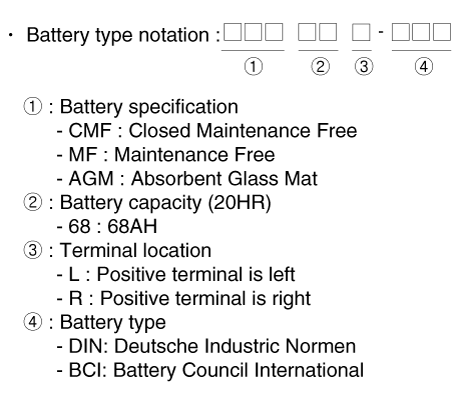
|
| • |
Cold Cranking Ampere (CCA): Cold Cranking Amps is a rating used
in the battery industry to define a battery's ability to start an
engine in cold temperatures.
|
| – |
The rating is the number of amps a new, fully charged battery
can deliver at -18°C(-0.4°F) for 30 seconds, while maintaining a
voltage of at least 7.2 volts for a 12 volt battery.
|
| – |
The higher the CCA rating, the greater the starting power of
the battery.
|
| • |
RESERVE CAPACITY (RC) : Reserve Capacity is a battery industry
rating, defining a battery's ability to power a vehicle with an
inoperative alternator or fan belt.
|
| – |
The rating is the number of minutes a battery at 26.7 °C(80 °F)
can be discharged at 25 amps and maintain a voltage of 10.5 volts
for a 12 volt battery.
|
| – |
The higher the reserve rating, the longer your vehicle can operate
should your alternator or fan belt fail.
|
|
|
BCI Type
Capacity
(5 hr / 20 hr)
|
Length
|
Width
|
Height
|
Total Height
|
L (mm)
|
W (mm)
|
H (mm)
|
TH (mm)
|
28/35
|
188 - 192
|
126 - 130
|
198 - 202
|
218 - 222
|
32/40
|
194 - 198
|
133 - 137
|
199 - 203
|
223 - 227
|
36/45
|
203 - 207
|
173 - 177
|
200 - 204
|
221 - 225
|
44/55
|
213 - 217
|
173 - 177
|
198 - 202
|
218 - 222
|
48/60
|
228 - 232
|
173 - 177
|
200 - 204
|
221 - 225
|
54/68
|
258 - 262
|
173 - 177
|
198 - 202
|
220 - 224
|
56/70
|
258 - 262
|
173 - 177
|
198 - 202
|
223 - 227
|
64/80
|
274 - 278
|
170 - 174
|
198 - 202
|
221 - 225
|
70/88
|
349 - 353
|
172 - 176
|
186 - 200
|
183 - 187
|
72/90
|
300 - 304
|
170 - 174
|
200 - 204
|
221 - 225
|
76/95
|
294 - 298
|
172 - 176
|
198 - 202
|
220 - 224
|
80/100
|
326 - 330
|
170 - 174
|
203 - 207
|
225 - 229
|
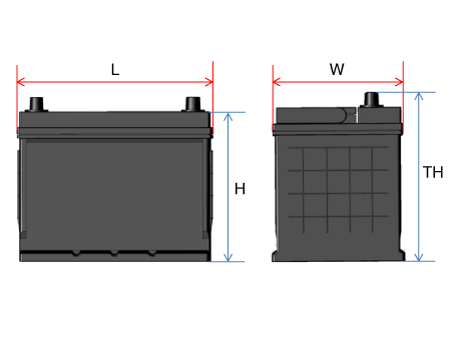
DIN Type
Capacity
(5 hr / 20 hr)
|
Length
|
Width
|
Height
|
Total Height
|
L (mm)
|
W (mm)
|
H (mm)
|
TH (mm)
|
36/45
|
205 - 207
|
173 - 175
|
164 - 168
|
188 - 190
|
48/60
|
240 - 242
|
173 - 175
|
164 - 168
|
188 - 190
|
54/68
|
276 - 278
|
173 - 175
|
164 - 168
|
188 - 190
|
64/80
|
313 - 315
|
173 - 175
|
164 - 168
|
188 - 190
|
72/90
|
351 - 353
|
173 - 175
|
164 - 168
|
188 - 190
|
80/100
|
351 - 353
|
173 - 175
|
164 - 168
|
188 - 190
|
88/110
|
392 - 394
|
173 - 175
|
164 - 168
|
188 - 190
|
AGM DIN Type
Capacity
(5 hr / 20 hr)
|
Length
|
Width
|
Height
|
Total Height
|
L (mm)
|
W (mm)
|
H (mm)
|
TH (mm)
|
40/50
|
205 - 207
|
173 - 175
|
164 - 168
|
188 - 190
|
48/60
|
227 - 229
|
173 - 175
|
164 - 168
|
188 - 190
|
56/70
|
276 - 278
|
173 - 175
|
164 - 168
|
188 - 190
|
64/80
|
312 - 314
|
173 - 175
|
164 - 168
|
188 - 190
|
72/90
|
351 - 353
|
173 - 175
|
164 - 168
|
188 - 190
|
84/105
|
392 - 394
|
173 - 175
|
164 - 168
|
188 - 190
|
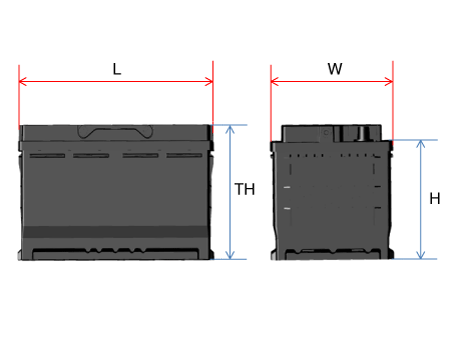
|
Description and operation
AGM Battery
AGM battery is used for especially heavy load on the vehicle network depending
on equipment and requirements. AGM stands for Absorbent Glass Material Battery;
that is absorbent glass fibre fleece. AGM batteries are fitted in models with electrical
loads/consumers which have a high energy demand.The constantly increasing energy
demand of modern vehicle electrical systems calls for ever more powerful battery
solutions.The power consumption is considerable even when the vehicle is parked.The
somewhat higher price compared with a battery of similar size is fully balanced
by the following benefits:
| – |
Significantly longer service life
|
| – |
Increased starting reliability at low temperatures
|
| – |
100 % freedom from maintenance
|
| – |
Low risk in event of an accident (reduced risk to the environment)
|
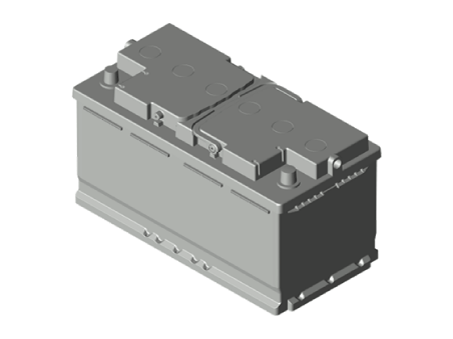
CMF Battery
| 1. |
The CMF(Closed Maintenance Free) battery is, as the name implies, totally
maintenance free and has no removable battery cell caps.
|
| 2. |
The CMF(Closed Maintenance Free) battery does not require water replenishment
for the repair.
|
| 3. |
The battery is completely sealed, except for small vent holes in the
cover.
|
| • |
After disconnecting then reconnecting the battery negative cable,
reset some parts that require the reset procedures.
(Refer to Body Electrical System - "General Information")
|
|
Repair procedures
| 1. |
Turn the ignition switch OFF.
|
| 2. |
Remove the luggage covering (A).
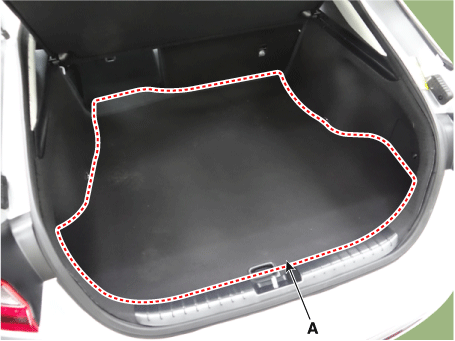
|
| 3. |
Remove the luggage center tray (A).
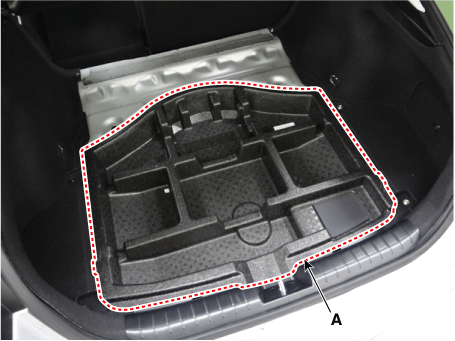
|
| 4. |
Turn the ignition switch OFF and disconnect the battery negative (-)
terminal (A).
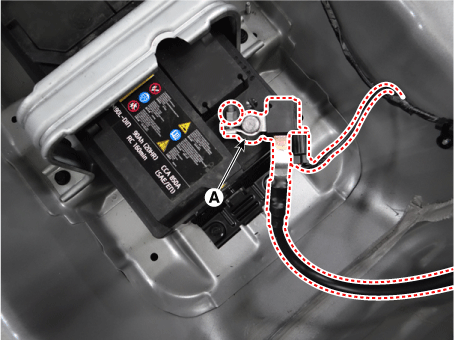
|
| 5. |
Disconnect the battery positive (+) terminal (A).
|
| 6. |
Disconnect the vent hose (B).
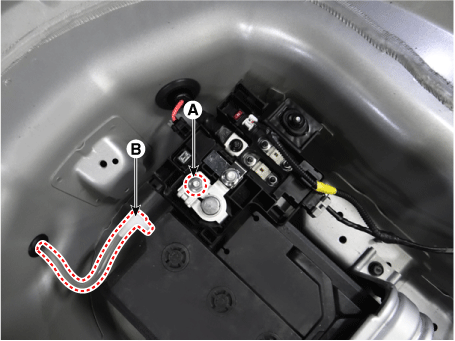
|
| 7. |
Remove the mounting band (A).
|
| 8. |
Remove the mounting bracket (B) and then remove the battery.
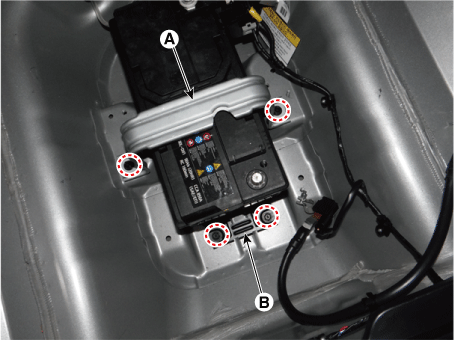
|
| 1. |
Install in the reverse order of removal.
|
Electrolyte Level Inspection
(MF Openable Battery only)
| 1. |
Check that the electrolyte level lies between the “UPPER” and the “LOWER”
lines.
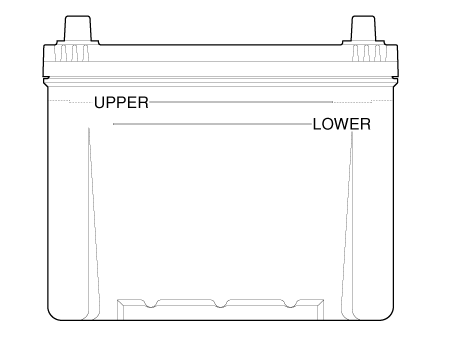
|
| 2. |
If the electrolyte level is below the "LOWER" line, add water until the
level of electrolyte comes up to the "UPPER" level.
| (1) |
Remove the cell caps (A) and then carefully add distilled or
purified water to bring the level of electrolyte in each cell to
the "UPPER" line.
|
| (2) |
Put the cell caps back on the battery.
|
| (3) |
Charge the battery to mix the water and residual acid in the
battery.
|
• |
Never use the water with impurities or additives
to fill the battery cells. It will reduce the life
and performance of the battery.
|
|
• |
Do not overfill the battery cells. It may result
in an "overflow" of the acid electrolyte and cause
corrosion on adjacent metal parts, performance deterioration
and shortening the life span.
|
|
• |
Make sure the cell caps are installed securely
before charging the battery after filling the battery
cells.
|
|
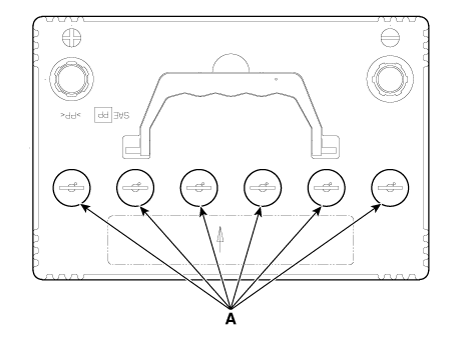
|
|
Battery Charging
In general, vehicle battery charging system has three forms.
| 1. |
Constant current charge: The battery voltage gradually rises by charging
with setting a constant current. If charging current and time are not managed
correctly, the battery is over-charged, therefore charging should be stopped
after confirming the completion of charging.
| – |
General charge: Charging the battery for a long time with low
current
|
| – |
Quick charge: Charging the battery for a short time with high
current
|
|
| 2. |
Constant voltage charge: The battery charge current is gradually reduced
by charging with setting a constant voltage.
|
|
If the battery is charged directly at the battery terminals on vehicles
with battery sensor, misinterpretations of battery condition and under certain
circumstances also unwanted Check Control messages or fault memory entire
can occur.
After recharging finished, let the battery stand for over 10 hours with
normal temperature for battery stabilization.
|
Battery Voltage and
Status
Check the battery voltage and status using the battery tester.
Battery Terminal
| 1. |
Move back and forth to check if the battery terminals (A) are loose or
corroded. If the terminals are corroded, clean them.

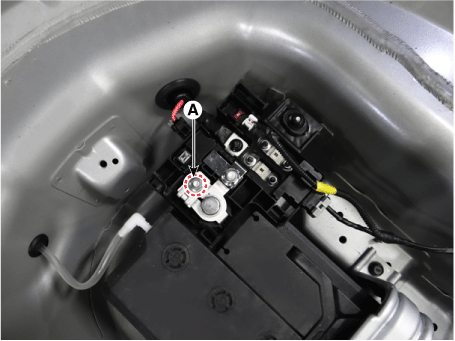
If battery positive connection is loose, disconnect ground(GND) cable
first before attempting to remove or tighten plus connection, to prevent
personal injury.
|
| 2. |
If the battery clamp on battery positive (+) terminal is not seated securely:
| (1) |
Turn ignition switch OFF and disconnect the battery negative
(-) terminal.
|
| (2) |
Tighten battery clamp (A) on battery positive (+) terminal
|
Battery positive (+) terminal:
7.8 - 9.8 N·m (0.8 - 1.0 kgf·m, 5.8 - 7.2 lb·ft)
|

|
|
| 3. |
If the battery clamp on battery negative (-) terminal is not seated securely:
| (1) |
Tighten battery clamp (A) on battery negative (-) terminal.
|
Battery negative (-) terminal:
7.8 - 9.8 N·m (0.8 - 1.0 kgf·m, 5.8 - 7.2 lb·ft)
|

|
|
Battery Condition
Check the battery for damage or deformation. If severe damage, deformation or
leakage is found, replace the battery.
Vehicle parasitic current
inspection
[Using the Ammeter]
| 1. |
Turn the all electric devices OFF, and then turn the ignition switch
OFF.
|
| 2. |
Close all doors except the engine hood, and then lock all doors.
| (1) |
Disconnect the hood switch connector.
|
| (3) |
Close the doors or remove the door switches.
|
|
| 3. |
Wait for a few minutes until the vehicle’s electrical systems go to sleep
mode.
| •
|
For an accurate measurement of a vehicle parasitic current,
all electrical systems should go to sleep mode. (It takes
at least one hour or at most one day.) However, an approximate
vehicle parasitic current can be measured after 10 - 20
minutes.
|
|
|
| 4. |
Connect an ammeter in series between the battery (-) terminal and the
ground cable, and then disconnect the clamp from the battery (-) terminal
slowly.
| •
|
Be careful that the lead wires of an ammeter do not come
off from the battery (-) terminal and the ground cable to
prevent the battery from being reset. In case the battery
is reset, connect the battery cable again, and then start
the engine or turn the ignition switch ON for more than
10 sec. Repeat the procedure from No. 1.
To prevent the battery from being reset during the inspection,
|
| 1) |
Connect a jump cable between the battery (-) terminal
and the ground cable.
|
| 2) |
Disconnect the ground cable from the battery (-) terminal.
|
| 3) |
Connect an ammeter between the battery (-) terminal and
the ground cable.
|
| 4) |
After disconnecting the jump cable, read the current
value of the ammeter.
|
|
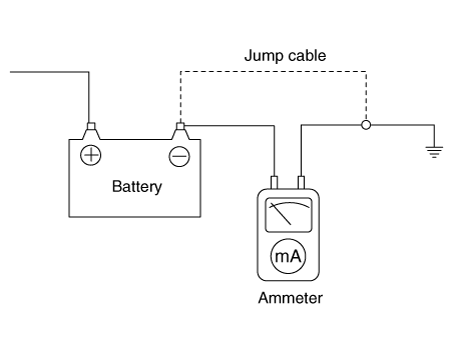
|
| 5. |
Read the current value of the ammeter.
| • |
If the parasitic current is over the limit value, search for
abnormal circuit by removing the fuses one by one and checking for
parasitic current.
|
| • |
Reconnect only the fuse suspected of parasitic current and search
for the trouble unit by removing the components connected to the
circuit one by one until the parasitic draw drops below limit value.
|
|
Limit value (after 10 - 20 min.) : Below 50mA
|
|
[Using the Clamp type Ammeter]
| 1. |
Turn the all electric devices OFF, and then turn the ignition switch
OFF.
|
| 2. |
Close all doors except the engine hood, and then lock all doors.
| (1) |
Disconnect the hood switch connector.
|
| (3) |
Close the doors or remove the door switches.
|
|
| 3. |
Wait for a few minutes until the vehicle’s electrical systems go to sleep
mode.
| •
|
For an accurate measurement of a vehicle parasitic current,
all electrical systems should go to sleep mode. (It takes
at least one hour or at most one day.) However, an approximate
vehicle parasitic current can be measured after 10 - 20
minutes.
|
|
|
| 4. |
Install the clamp type ammerter on battery negative (-) terminal.
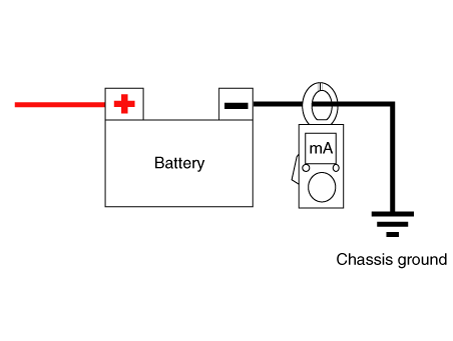
|
| 5. |
Read the current value of the ammeter.
| • |
If the parasitic current is over the limit value, search for
abnormal circuit by removing the fuses one by one and checking for
parasitic current.
|
| • |
Reconnect only the fuse suspected of parasitic current and search
for the trouble unit by removing the components connected to the
circuit one by one until the parasitic draw drops below limit value.
|
|
Limit value (after 10 - 20 min.) : Below 50mA
|
|
| 1. |
Make sure the ignition switch and all accessories are in the OFF position.
|
| 2. |
Disconnect the battery cables (negative first).
|
| 3. |
Remove the battery from the vehicle.
| •
|
Care should be taken in the event the battery case is
cracked or leaking, to protect your skin from the electrolyte.
Heavy rubber gloves (not the household type) should be
wore when removing the battery.
|
|
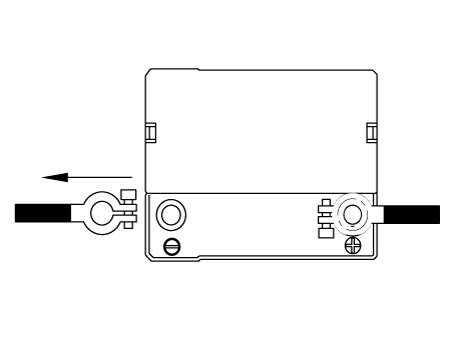
|
| 4. |
Inspect the battery tray for damage caused by the loss of electrolyte.
If acid damage is present, it will be necessary to clean the area with a
solution of clean warm water and baking soda. Scrub the area with a stiff
brush and wipe off with a cloth moistened with baking soda and water.
|
| 5. |
Clean the top of the battery with the same solution as described above.
|
| 6. |
Inspect the battery case and cover for cracks. If cracks are present,
the battery must be replaced.
|
| 7. |
Clean the battery posts with a suitable battery post tool.
|
| 8. |
Clean the inside surface of the terminal clamps with a suitable battery
cleaning tool. Replace damaged or frayed cables and broken terminal clamps.
|
| 9. |
Install the battery in the vehicle.
|
| 10. |
Connect the cable terminals to the battery post, making sure tops of
the terminals are flush with the tops of the posts .
|
| 11. |
Tighten the terminal nuts securely.
|
| 12. |
Coat all connections with light mineral grease after tightening.
| •
|
When batteries are being charged, an explosive gas forms
beneath the cover of each cell. Do not smoke near batteries
being charged or which have recently been charged. Do not
break live circuit at the terminals of batteries being charged.
A spark will occur when the circuit is broken. Keep open
flames away from battery.
|
|
|
Troubleshooting
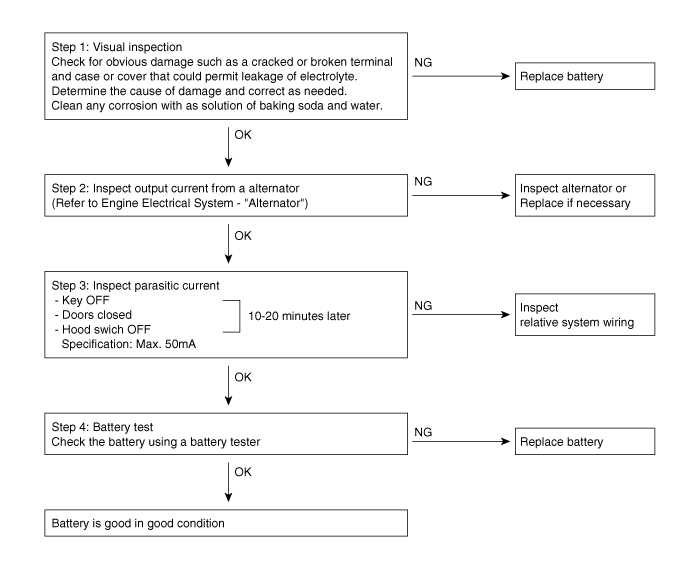
Components and components location
Components Location
Description and operation
Description
Due to the considerably more frequent occurrence of starting operations, th ...
Description and operation
Description
Vehicles have many control units that use more electricity. These units control
their own system based on information from diverse sensors. It is ...
Other information:
■ Head lamp - Type A
■ Head lamp - Type B
(1) Headlamp (Low/High) (bulb type)
(2) Front turn signal lamp (bulb type)
(3) Day time running lamp / Position lamp (LED type)
(4) Side marker (bulb type)
(5) Headlamp (Low/High) (LED type)
(6) Headlamp (Low/High assist) (LED type)
(7) Front ...
Repair procedures
Removal
In case of removing the high pressure fuel pump, high pressure fuel pipe,
delivery pipe, and injector, there may be injury caused by leakage of the
high pressure fuel. So don’t do ...


 DC DC converter
DC DC converter Battery Sensor
Battery Sensor
















